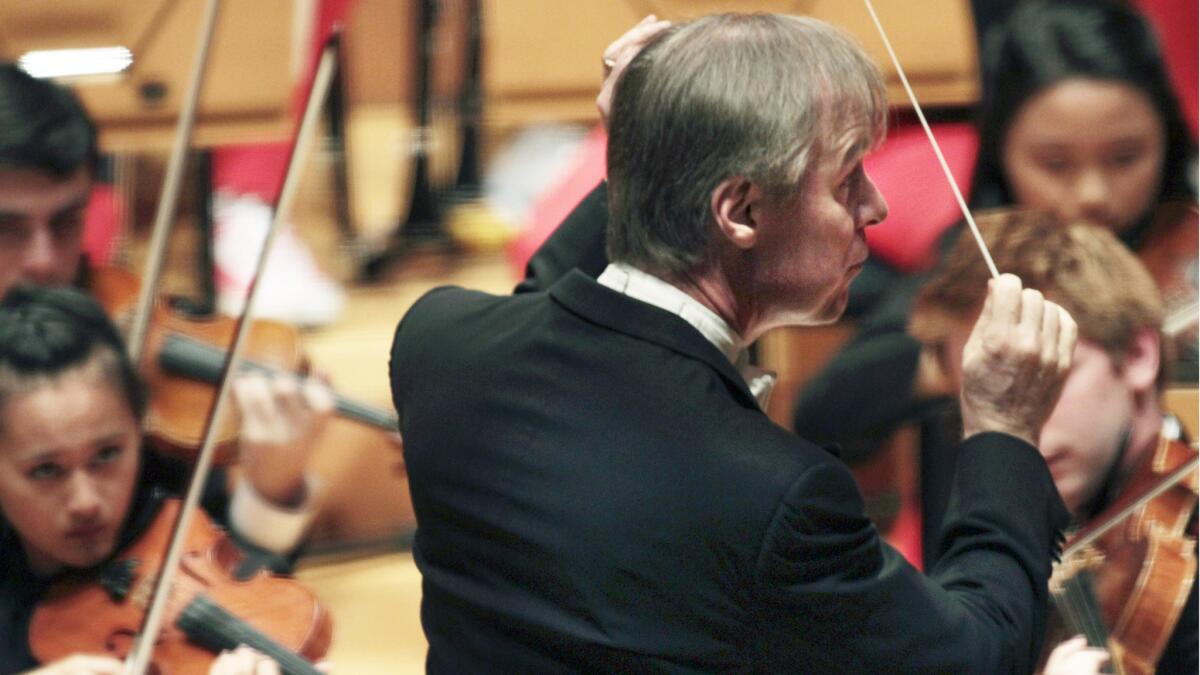National Youth Orchestra is sensational at Disney Hall

- Share via
Fashion first: The orchestra was dressed normally from waist up in dark jackets. But the pants were tight, flaming red on men and women. The shoes were stars-and-stripes sneakers. David Robertson retained the white-tie-and-tails uniform of an orchestra conductor but merrily jogged onstage of Walt Disney Concert Hall on Tuesday night sporting the same red-white-and-blue footwear and a huge grin.
This was the final concert on the tour of the National Youth Orchestra of the United States of America, a summer training program founded last year by Carnegie Hall for 120 musicians ages 16 to 19. Last year, Valery Gergiev was their conductor, and the orchestra played on the East Coast, at the London Proms and in Russia.
This summer it is under Robertson, the intrepid music director of the St. Louis Symphony, and toured the U.S., winding up in L.A. The orchestra is sensational. It doesn’t look professional, with the kids in their youthful uniforms. It doesn’t act professional, kids showing an unbound gusto for the music they were making, outdone only by Robertson exhibiting even unashamed pleasure in every gesture on the podium and off.
The orchestra doesn’t even promote musical professionalism. It will not accept college students who are music majors. The idea is to promote, instead, music as part of life, whatever path these talented young people follow.
But close your eyes and NYO-USA has another story to tell altogether. This very large orchestra not only played with ferocious spirit and genuine personality, but it also produced refined performances notable for credible polish.
Why do we need a National Youth Orchestra? As if that weren’t self-evident, Robertson addressed the audience with an irrefutably great answer. Every instrument in the orchestra, he explained, comes from a different place, has a different history, a different shape, a different sound. But take a single one away and you will immediately notice something significant is missing.
The orchestra, he concluded, symbolizes the way in which “the things that unite us are far, far stronger than the things that would seem to keep us apart.” He didn’t need to say that the 120 players who faced him happened to be, themselves, a decent reflection of American diversity.
The program began with Leonard Bernstein’s Symphonic Dances from “West Side Story,” that iconic musical representation of American cultures at war with each other in New York 70 years ago.
A lot can be said about the panache these youngsters brought to Bernstein’s jazzy score, with its Latin rhythms and Italianate lyricism. But other cultures were welcomed into this revelatory performance. An extraordinary flute solo near the end had the expressive flavor of ancient Japanese court music, stopping time for an important few seconds.
But even more must be said about Robertson, whose conducting from first note to last in a long evening was not simply inspirational (that’s expected) but inspired. He was an Energizer bunny on stage, shaping phrases with his hands and his dancing feet (those sneakers appeared to have a liberating effect on him). He crouched, lunged, turned to the audience and shouted out “mambo,” and, as if in every single musician’s face, enforced rhythmic exuberance and intensely sensitive dynamics.
The other American music was Samuel Adams’ “Radial Play.” Part of the NYO-USA project is the commissioning of a piece each summer, providing the students the opportunity to work with an American composer. Adams’ score is short, only five minutes, and operates on the idea of what the composer calls in the program notes “music orbits” around pitch centers.
More explanation would be nice, but it’s an alluring piece in which a listener does, in fact, get a sensation of sonic clouds swirling in a starry sky. That the young composer happens to be the son of John Adams means that he no doubt grew up learning his way around the orchestra, and that shows in his sure hand for instrumental effects, from the first harp notes to the final impressionistic bursts in the full ensemble. But his sound universe is his own, as is his slowly evolving musical pace. I would not have been unhappy if “Radial Play” played longer.
The big pieces were Britten’s Violin Concerto, with Gil Shaham, also in sneakers, as soloist, and Mussorgsky’s “Pictures at an Exhibition.” Britten’s early, ambitiously serious concerto gave the young players an exercise in finding eerie instrumental complements to a fleet soloist.
Robertson used Ravel’s orchestrations of Mussorgsky’s musical pictures to highlight a number of outstanding fluid wind solos, as well as to wonderfully exaggerate the effects of big strings, big brass and big percussion. It was, from start to finish, full of edge-of-seat thrills.
Next year, Charles Dutoit will be the NYO-USA conductor, and it will travel to China. The red pants might not be such a good idea for that. But save the sneakers; they may contain magical properties.
More to Read
The biggest entertainment stories
Get our big stories about Hollywood, film, television, music, arts, culture and more right in your inbox as soon as they publish.
You may occasionally receive promotional content from the Los Angeles Times.











